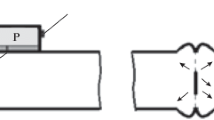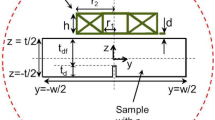Abstract
The ultrasonic pulse-echo backscattered amplitude integral (BAI)-mode imaging technique [IEEE Trans. UFFC, 45:30 (1998)] has demonstrated sensitive detection of subwavelength channel defects (38-μm diameter reliably and 6-μm diameter occasionally) in flexible 220-μm-thick food package seals (17.3 MHz, λ ≈ 86 μm). However, the underlying subwavelength defect detection mechanism is poorly understood. In this contribution, a theoretical modeling study was undertaken to elucidate the mechanism. The subwavelength diameter channel was fused in-between two plastic package films by applying heat from one side of the films. The sample cross-section microstructure was characterized from both optical and acoustic images. The cross-section impedance profiles along sample thickness dimension were determined. Although identical in nominal impedance properties before sealing, the two binding films showed an asymmetric impedance profile after sealing. Transient finite-element heat conduction analysis and impedance profiles of multiple-sealed package samples showed that the single-sided heating process caused an asymmetric impedance profile. A generalized impedance model was proposed based on these observations. An efficient two-dimensional simulation tool using a finite-difference time-domain method and the perfectly matched layer numerically evaluated the defect detection behavior of the radio-frequency (rf) echo waveforms. The normalized correlation coefficients between the simulated and the measured rf echo waveforms were greater than 95% for this generalized model, which suggested the validity of the proposed impedance model.
Similar content being viewed by others
Reference
K. Raum, A. Ozguler, S. A. Morris, and W. D. O'Brien, Jr., “Channel defect detection in shelf-stable food packages using high-frequency pulse-echo imaging,” IEEE Trans. Ultrason., Ferroelect., Freq. Contr. 45, pp. 30-40 (1998).
C. H. Frzaier, Q. Tian, A. Ozguler, S. A. Morris, and W. D. O'Brien, Jr., “High contrast ultrasound images of defects in food package seals,” IEEE Trans. Ultrason., Ferroelect., Freq. Contr. 47, pp. 530-539 (2000).
Ozguler, S. A. Morris, and W. D. O'Brien, Jr., “Evaluation of defects in seal region of food packages using the backscattered amplitude integral (BAI) technique,” in 1997 IEEE Ultrasonics Symposium Proceedings, edited by S. C. Schneider, M. Levy, and B. R. McAovy, vol 1, pp. 689-692, (Toronto, Canada, 1997).
Ozguler, S. A. Morris, and W. D. O'Brien, Jr., “Evaluation of defects in the seal region of food packages using the ultrasonic contrast descriptor, δBAI,” Packaging Technol. Sci. 12, pp. 161-171 (1999).
X. Yin, S. A. Morris, and W. D. O'Brien, Jr., “Investigation of spatial sampling resolution of the real-time ultrasound pulse-echo BAI-mode imaging technique,” in 2001 IEEE Ultrasonics Symposium Proceedings, edited by S. C. Schneider, M. Levy, and B. R. McAovy, vol 1, pp. 729-732, (Atlanta, GA, 2001).
X. Yin, S. A. Morris, and W. D. O'Brien, Jr., “Experimental spatial sampling study of the real-time ultrasonic pulse-echo BAI-mode imaging technique,” IEEE Trans. Ultrason., Ferroelect., Freq. Contr. 50, pp. 428-440 (2003).
A. D. Pierce, Acoustics: An Introduction to Its Physical Principles and Applications (The Acoustical Society of America, Woodbury, NY, 1989).
K. S. Yee, “Numerical solution of initial boundary value problems involving Maxwell's equations in isotropic media,” IEEE Trans. Antennas and Propagation 14, pp. 302-307 (1966).
P. Berenger, “A perfectly matched layer for the absorption of electromagnetic waves,” J. Comput. Phys. 114, pp. 185-200 (1994).
X. Yuan, D. Borup, J. W. Wiskin, M. Berggren, R. Eidens, and S. A. Johnson, “Formulation and validation of Berenger's PML absorbing boundary for the FDTD simulation of acoustic scattering,” IEEE Trans. Ultrason., Ferroelect., Freq. Contr. 44, pp. 816-822 (1997).
H. Chang and R. M. D'angelo, “Experimental verification of finite-difference model for ultrasonic evaluation of complex structures,” in 1990 IEEE Ultrasonics Symposium Proceedings, edited by B. R. McAvoy, vol 2, pp. 965-969, (Honolulu, HI, 1990).
P. H. Johnston and E. I. Madaras, “Modeling the pulse-echo response of a two-dimensional phase-insensitive array for NDE of layered media,” 1988 IEEE Ultrasonics Symposium Proceedings, edited by B. R. McAvoy, vol 2, pp. 1021-1025, (Chicago, IL, 1988).
R. Stacey and J. P. Weight, “Ultrasonic pulse-echo responses from targets in solid media using finite difference methods,” IEE Proceedings-A 140, pp. 303-316, (1993).
L. P. Martin, D. H. Chambers, and G. H. Thomas, “Experimental and simulated ultrasonic characterization of complex damage in fused silica,” IEEE Trans. Ultrason., Ferroelect., Freq. Contr. 49, pp. 255-265, (2002).
K. L. Shlager and J. B. Schneider, “A selective survey of the finite-difference time-domain literature,” IEEE Antennas and Propagation Magazine 37, pp. 39-57, (1995).
A. Taflove, “Review of the Formulation and Applications of the Finite-Difference Time-Domain Method of Numerical Modeling of Electromagnetic Wave Interactions with Arbitrary Structures,” Wave Motion 10, pp. 547-582, (1988).
W. Manry Jr., S. L. Broschat and J. B. Schneider, “Higher-order FDTD methods for large problems,” J. Appl. Comput. Electromag. Soc. 10, pp. 17-29, (1995).
J. A. Jensen, User's guide for the FIELD-II program. Available: http://www.es.oersted.dtu.dk/staff/jaj/field/information/users_guide.pdf.
V. A. Dumane and P. M. Shanker, “Use of frequency diversity and Nakagami statistics in ultrasonic tissue characterization,” IEEE Trans. Ultrason., Ferroelect., Freq. Contr. 48, pp. 1139-1146 (2001).
R. Lerch, H. Landes and H. T. Kaarmann, “Finite element modeling of the pulse-echo behavior of ultrasound transducers,” in 1994 IEEE Ultrasonics Symposium Proceedings, edited by S. C. Schneider, M. Levy, B. R. McAovy, vol. 2, pp. 1021-1025 (Cannes, France, 1994).
E. Skudrzyk, The Foundations of Acoustics (Springer-Verlag, New York, NY, 1971).
K. Raum and W. D. O'Brien, Jr., “Pulse-echo field distribution measurement technique for high-frequency ultrasound sources,” IEEE Trans. Ultrason., Ferroelect., Freq. Contr. 44, pp. 810-815 (1997).
W. S. Janna, Engineering Heat Transfer, 2nd ed.(CRC Press LLC, Boca Raton, FL, 2000).
T. P. R. C. of Purdue University, Thermophysical Properties of Matter (IFI/Plenum, New York, 1970–1979).
Material properties online database. Available: http://www.matweb.com.
Author information
Authors and Affiliations
Corresponding author
Rights and permissions
About this article
Cite this article
Yin, X., Morris, S.A. & O'Brien, W.D. Ultrasonic Pulse-Echo Subwavelength Defect Detection Mechanism: Experiment and Simulation. Journal of Nondestructive Evaluation 22, 103–115 (2003). https://doi.org/10.1023/B:JONE.0000010737.63227.f4
Issue Date:
DOI: https://doi.org/10.1023/B:JONE.0000010737.63227.f4




